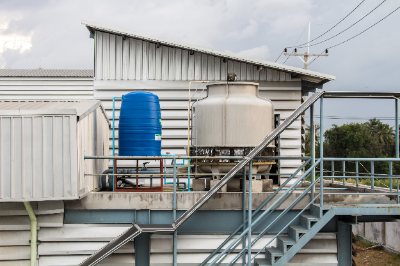What Is a Cooling Tower?

A cooling tower is a device designed to produce cooling water by lowering its temperature, utilizing the heat of vaporization caused by water evaporation. This principle is similar to the cooling effect of waterfalls in nature. The water used in cooling towers is typically heated by heat exchange in compressors and chillers and is cooled for reuse, enhancing the efficiency of chillers.
Uses of Cooling Towers
Cooling towers are widely used for air conditioning in buildings, shopping malls, and hospitals, as well as for cooling machinery in district heating and cooling systems, factories, and power plants.
There are two types of cooling towers: open and enclosed. Open cooling towers allow direct contact between the outside air and the cooling water, making them more efficient for air conditioning. Enclosed cooling towers, on the other hand, cool by passing the water through a heat exchanger tube and spraying water on the tube, thus avoiding contamination of the cooling water.
Principles of Cooling Towers
Cooling towers leverage the latent heat of water evaporation, which is about 2500 kJ/kg at room temperature, with the specific heat of water being 4.2 kJ/(kg-K). Evaporating 1% of the water can lower the temperature of the remaining water by approximately 6°C.
In open-type cooling towers, a fan draws in outside air, and the liquid to be cooled is efficiently contacted with the air by being poured from above. By dispersing water onto filling material with a large surface area, the contact area with the outside air is increased, enhancing the cooling effect.
For closed cooling towers, the process is similar in terms of air intake, but there is no filler material, and instead, a tube is present. The liquid to be cooled passes through these tubes, and by spraying water over them, the sprayed water vaporizes, indirectly cooling the liquid inside the tubes.
Both open and enclosed cooling tower systems require regular maintenance and cleaning to ensure sanitation and prevent the growth of legionella bacteria, which is a legal requirement.